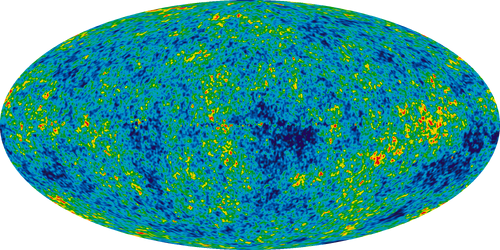
The detailed, all-sky picture of the infant universe created from nine years of WMAP data. The image reveals 13.77 billion year old temperature fluctuations (shown as color differences) that correspond to the seeds that grew to become the galaxies. The signal from our galaxy was subtracted using the multi-frequency data. This image shows a temperature range of ± 200 microKelvin.
The explosive event that is theorized to be the beginning of the universe.[1] Time, space, energy and matter are all thought to have come into existence 13.7 billions years ago, in the event called the Big Bang.[2]
In its first moments, the universe was infinitely dense, unimaginably hot, and contained pure energy; but within a tiny fraction of a second, vast numbers of of fundamental particles had appeared, created out of energy as the universe cooled. Within a few thousand years, these particles combined to form the first atoms.[2]
References[]
- ^ Baumann, Mary K.; Will Hopkins, Loralee Nolletti, Michael Soluri, Steven Hawking (foreword) and Ray Villard (astronomy consultant) (2007). Cosmos: Images From Here to the Edge of the Universe. London: Duncan Baird Publishers. ISBN 1844834761 Check
|isbn=value: checksum (help). Cite uses deprecated parameter|coauthors=(help); Check date values in:|access-date=(help); - ^ a b Rees, Martin (ed.) (2008). Universe: The Definitive Visual Guide. Dorling Kindersley Inc. ISBN 9780756636708.

|
This article is part of Project Science Glossary, a All Birds project that aims to write comprehensive articles on each term related to science. |

|
This article is part of Project Astronomy, a All Birds project that aims to write comprehensive articles on each term related to astronomy. |
| |||||||||||||||||||||||||
| group3 = Types of dark matter | abbr3 = 3 | list3 =
}} }} }} }}
